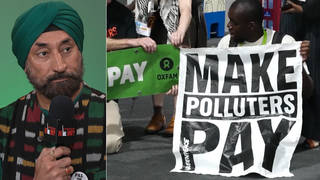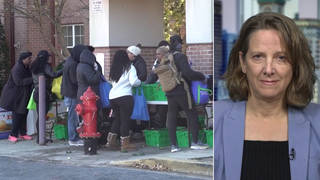
Topics
Guests
- Jim WeillPresident of the Food Research and Action Center, or FRAC, a national anti-hunger public policy group based in Washington, D.C.
Government officials are projecting the number of Americans receiving food stamps will reach a record twenty-eight million later this year. Over the past year, more than forty states saw the number of food stamp recipients rise. A ten percent jump in food stamp recipients was recorded in six states: Arizona, Florida, Maryland, Nevada, North Dakota and Rhode Island. In West Virginia, one-in-six residents now receive food stamps. We speak with Jim Weill, president of the Food Research and Action Center. [includes rush transcript]
Transcript
AMY GOODMAN: US government officials are projecting the number of Americans receiving food stamps will soon reach a record twenty-eight million. The number of food stamp recipients is quickly rising across the nation. Forty states reported an increase in food stamp recipients last year. The biggest increases were in Arizona, Florida, Maryland, Nevada, North Dakota and Rhode Island. In West Virginia, one-in-six residents now receive food stamps.
This comes as the price of food is soaring. Over the past year the price of milk in the US has risen 17 percent. Rice, pasta and bread prices have jumped over 12 percent. And the price of eggs has risen by 25 percent. It’s the highest grocery inflation since the early ’90s.
Jim Weill joins us now from Washington, D.C., president of Food Research and Action Center, known as FRAC, a national anti-hunger public policy group. What’s happening, Jim?
JIM WEILL: Well, two things are happening. One, people are losing jobs, their losing hours of work, their wages are going down, so they need more assistance from the government in the form of food stamps and other help. And two, food prices are rising faster than they have in many years, and they’re particularly rising for staples that low-income people buy. The government’s cost-of-living index for the Thrifty Food Plan, which is the cheapest food plan the government has, has risen one-and-a-quarter percent faster over the last year than the rapidly rising price of food generally. So the poor are facing a double whammy. Last week at an anti-hunger summit in Massachusetts, Governor Patrick compared it to Katrina in its effect on low-income families in this country.
AMY GOODMAN: I just learned about a new field of journalism. I was down speaking at Washington and Lee this past weekend in Lexington, Virginia, and there was a special meeting of the Society of Professional Journalists there, and one of the seminars was on poverty journalism, how to cover poverty in this country. They were talking particularly about places like West Virginia. West Virginia, one-in-six people there are on food stamps; in Ohio, one-in-ten?
JIM WEILL: Right. And according to the Oklahoma Department of Human Services, one-in-three children in Oklahoma has been on food stamps at least at some point during the last year. Often, people aren’t on for the entire year, but two, three or four months. One-in-three children in Oklahoma.
AMY GOODMAN: One-in-three kids?
JIM WEILL: That’s right.
AMY GOODMAN: Can you talk about how food stamps work?
JIM WEILL: Sure. Food stamps are primarily paid for by the federal government, but you apply through a state food stamp or welfare agency. It’s an entitlement program, so the good news is that as economic conditions can get worse, the program can grow to meet the needs of the additional families that fall into poverty or near poverty. You have to meet a very strict asset test and very strict income test. Those tests in some ways are much too strict, haven’t been changed in thirty years for inflation on the assets side. But once you’re eligible, and we’re now approaching twenty-eight million people who are eligible in this country — or who are receiving benefits — there are far more who are eligible, but not receiving it — once you get benefits, benefits average about $100 a month per person in the family. Those benefits are too small. Everybody agrees that they’re too small. And there’s legislation pending in Congress to improve them a little bit — not enough — in the nutrition title of the Farm Bill. One of the important things Congress has to do this month is get that nutrition title of that Farm Bill passed.
AMY GOODMAN: And what exactly does the Farm Bill say?
JIM WEILL: It improves benefits a little bit by changing the so-called standard deduction, which is part of how you compute benefits, and improving the minimum benefit that hasn’t gone up in a long time, and it makes eligibility a little easier for working families and other — low-income working families and others to get into the program. So it’s a big program, and it costs money to fix the problems with it. And the President has threatened to veto the bill because of the possibility of spending more money on the Farm Bill. But we really need to do this now.
AMY GOODMAN: What is the second stimulus package you’re calling for, Jim Weill?
JIM WEILL: Well, in the first stimulus package, which did some good things — it provided the tax rebate, including to families with very low or little or no tax liability; it provides them a rebate if they have earnings — the first rebate package did some good things, but it didn’t have any improvements in unemployment compensation, and it didn’t have any boost in food stamps, even though the economists and leaders on the Hill and former Treasury Secretary Rubin and Republican economists like Martin Feldstein and Ben Bernanke have all said that the two best ways to stimulate the economy, to move money into the economy quickly and to do good for people who are hurting the most, would be to boost food stamp benefits on a temporary basis and to improve unemployment insurance coverage.
So there is a second stimulus package probably moving through Congress in the next few weeks, and the two most fundamental things that has to do is tackle food stamps and unemployment compensation.
AMY GOODMAN: And the purchasing power of food stamps, what is the average? Something like $1 or $1.07 per person per meal?
JIM WEILL: Right. The average benefit is about $1 per meal per person in the family, which is not enough — it’s not enough to stave off hunger and certainly not enough to buy a healthy diet. One of the things to think about when we have these inadequate benefits in the food stamp program, which mostly goes to kids, is we’re not getting kids enough healthy food so that they can do well in school, so that they can develop, so they can stay healthy, so they can learn. So it’s really self-defeating to have benefit levels that are that low.
AMY GOODMAN: What’s causing the rise in food prices?
JIM WEILL: A variety of factors: more demand for food from overseas, India and China, as more people move into the middle class; competition for crops from biofuels — corn — a lot of corn is being bought up for use as fuel. Those are the two main factors people have pointed to.
AMY GOODMAN: Well, Jim Weill, I want to thank you very much for being with us. Jim is president of the Food Research and Action Center, known as FRAC, a national anti-hunger public policy group based in Washington, D.C. We’ll certainly link to your website.












Media Options